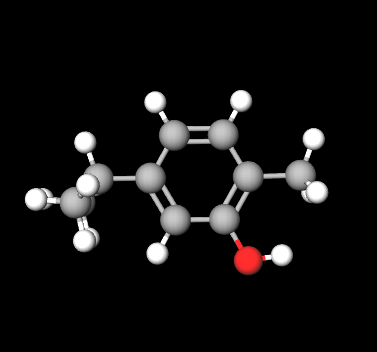Carvacrol is a natural phenolic compound primarily found in the essential oil of oregano and other aromatic plants. It is recognized for its potent antimicrobial, antioxidant, and anti-inflammatory properties, making it valuable in various cosmetic, pharmaceutical, and food applications.
Chemical Composition and Structure
The chemical composition of Carvacrol includes:
- Chemical Formula: C₁₀H₁₄O.
- Functional Groups: It contains a hydroxyl group (–OH) attached to a phenolic ring, which contributes to its bioactive properties.
Structurally, Carvacrol is characterized by its aromatic ring and aliphatic side chain, which enhance its stability and reactivity in various formulations.
Physical Properties
- Appearance: A colorless to pale yellow liquid.
- Solubility: Soluble in alcohol and oils; limited solubility in water.
- pH: Neutral, but can vary based on formulation.
- Odor: Strong, aromatic, and warm scent characteristic of oregano.
- Stability: Sensitive to light and air; should be stored in a cool, dark place to maintain potency.
Production Process
- Extraction: Carvacrol is typically extracted from the essential oil of oregano (Origanum vulgare) through steam distillation.
- Purification: The crude oil may undergo purification to isolate Carvacrol from other components.
- Formulation: The purified compound can be incorporated into various products, including cosmetics, dietary supplements, and food formulations.
Applications
- Medical: Used in herbal medicine for its antimicrobial and anti-inflammatory properties.
- Cosmetics: Commonly included in skincare products for its antioxidant effects and ability to promote skin health.
INCI Functions:
Perfuming. Unlike fragrance, which can also contain slightly less pleasant or characteristic odours, the term perfume indicates only very pleasant fragrances. Used for perfumes and aromatic raw materials.
- Food: Utilized as a natural preservative and flavoring agent due to its potent antimicrobial activity.
- Industrial Uses: Limited applications, primarily in natural product formulations.
Environmental and Safety Considerations
Carvacrol is generally regarded as safe for use in cosmetics and food products when applied according to recommended guidelines. However, individuals with specific sensitivities should exercise caution. Responsible sourcing and production practices are essential to ensure that Carvacrol is free from harmful contaminants and produced sustainably.
Molecular Formula C10H14O
Molecular Weight 150.22 g/mol
CAS 499-75-2
UNII 9B1J4V995Q
EC Number 207-889-6
Synonyms:
Isopropyl-o-cresol
Antioxine
5-Isopropyl-2-methylphenol
![]() Carvacrol
Carvacrol 


